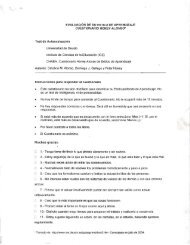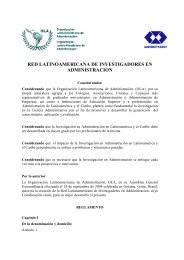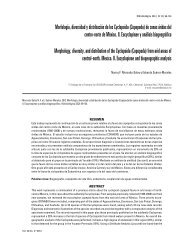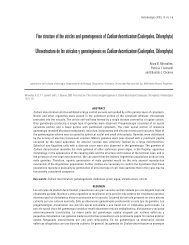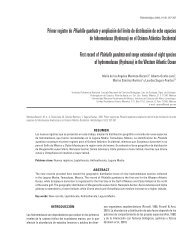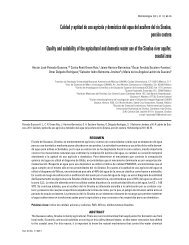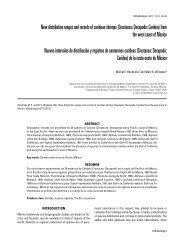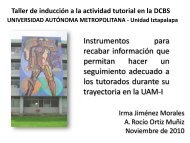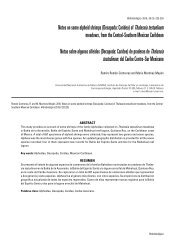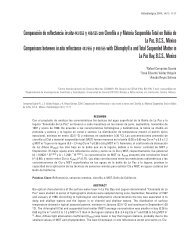Coherent states for the time dependent harmonic oscillator: the step ...
Coherent states for the time dependent harmonic oscillator: the step ...
Coherent states for the time dependent harmonic oscillator: the step ...
Create successful ePaper yourself
Turn your PDF publications into a flip-book with our unique Google optimized e-Paper software.
4 H. Moya-Cessa, M. Fernández Guasti / Physics Letters A 311 (2003) 1–5<br />
Let us consider that at <strong>time</strong> t = 0wehave<strong>the</strong><br />
system in <strong>the</strong> initial coherent state (5). From Fig. 2<br />
we can see that ̂T(0) = 1since ˙ρ = 0andlnρ = 0.<br />
There<strong>for</strong>e from (23), |ψ(0)〉=̂T † (0)|α〉=|α〉 0 =|α〉<br />
and from (22) we obtain <strong>the</strong> evolved wave function<br />
〉<br />
∣ ψ(t) = e<br />
−iÎ ∫ t<br />
ω(t)dt̂T 0 † |α〉=̂T †∣ ∣ αe<br />
−i ∫ t<br />
ω(t)dt〉 0 .<br />
(34)<br />
Note that <strong>the</strong> coherent state in <strong>the</strong> above equation is<br />
given in <strong>the</strong> original Hilbert space, i.e., in terms of<br />
number <strong>states</strong> given in (4). From Fig. 2 we can also see<br />
that <strong>for</strong> <strong>the</strong> maxima, ˙ρ(t max ) = 0andlnρ(t max ) = 0,<br />
<strong>the</strong>re<strong>for</strong>e ̂T † (t max ) = 1and<br />
∣ ψ(tmax ) 〉 = ∣ αe<br />
−i ∫ tmax<br />
0 ω(t)dt 〉 ,<br />
(35)<br />
i.e., we recover <strong>the</strong> initial coherent state. However, <strong>for</strong><br />
<strong>the</strong> minima, we have ˙ρ(t min ) = 0andlnρ(t min ) ≠ 0<br />
and <strong>the</strong>n we obtain<br />
∣ ψ(tmin ) 〉 = e i ln ρ(t min )<br />
2 ( ˆq ˆp+ ˆp ˆq) ∣ αe<br />
−i ∫ t min<br />
0 ω(t)dt 〉 , (36)<br />
that may be written in terms of annihilation and<br />
creation operators as<br />
∣ ψ(tmin ) 〉 = e lnρ(t min )<br />
2 ( ˆb 2 −( ˆb † ) 2 ) ∣ αe<br />
−i ∫ t min<br />
0 ω(t)dt 〉 , (37)<br />
that are <strong>the</strong> well-known squeezed (two-photon coherent)<br />
<strong>states</strong> [10]<br />
∣ ψ(tmin ) 〉 = ∣ αe<br />
−i ∫ t min<br />
0 ω(t)dt ; ln ρ(t min ) 〉 . (38)<br />
Squeezed <strong>states</strong>, just as coherent <strong>states</strong>, are also MUS.<br />
However <strong>the</strong> uncertainties <strong>for</strong> ˆq and ˆp are<br />
ˆq =<br />
1<br />
√<br />
2 ρ(tmin ) ,<br />
(39)<br />
and<br />
ˆp = ρ(t min)<br />
√<br />
2<br />
.<br />
(40)<br />
Fig. 2. ρ(t) as a function of t <strong>for</strong> ω 1 = 1andω 2 = 2 (solid line) and<br />
ω 2 = 3 (dashed line). ɛ = 20 and t s = 2.<br />
For <strong>time</strong>s in between we will have nei<strong>the</strong>r coherent<br />
<strong>states</strong> nor standard squeezed <strong>states</strong> (in <strong>the</strong> initial<br />
Hilbert space), but <strong>the</strong> wave function<br />
〉<br />
∣ ψ(t) = e<br />
−i ˙ρ ˆq2∣ 2ρ ∣ αe<br />
−i ∫ t<br />
0 ω(t′ )dt ′ ; ln ρ 〉 . (41)<br />
It should be stressed however, that in <strong>the</strong> instantaneous<br />
Hilbert space we will always have <strong>the</strong> coherent<br />
state (24).<br />
6. Conclusions<br />
Fig. 3. ω(t) as a function of t <strong>for</strong> ω 1 = 1andω 2 = 2 (solid line) and<br />
ω 2 = 3 (dashed line). ɛ = 20 and t s = 2.<br />
We have studied <strong>the</strong> problem of <strong>the</strong> <strong>time</strong> <strong>dependent</strong><br />
<strong>harmonic</strong> <strong>oscillator</strong> <strong>for</strong> a particular <strong>for</strong>m of <strong>time</strong> dependency,<br />
namely <strong>the</strong> <strong>step</strong> function. We have studied<br />
it from an invariant point of view that has made it possible<br />
to obtain analytic solutions. We have shown that,<br />
depending on <strong>the</strong> space we look at <strong>the</strong> solutions <strong>for</strong><br />
an initial coherent state, <strong>the</strong> state remains coherent or<br />
it may present squeezing. This squeezing may be enhanced<br />
by increasing <strong>the</strong> frequency difference of <strong>the</strong><br />
<strong>step</strong>.



